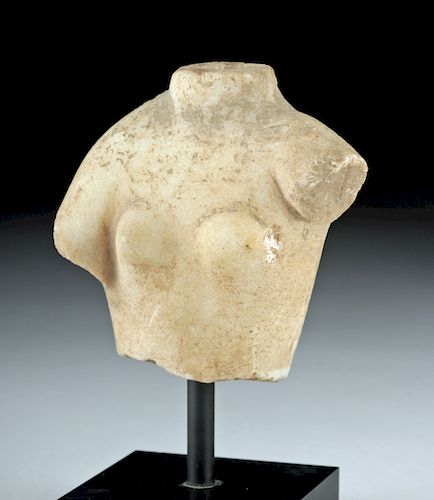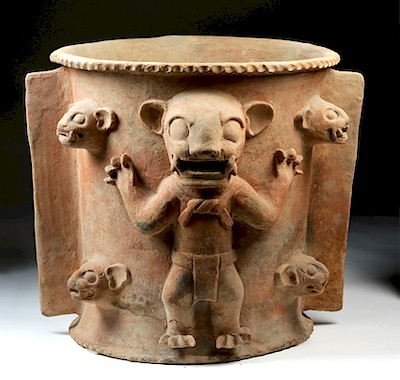Roman Marble Torso of a Female
Lot 35b
About Seller
Artemis Gallery
686 S Taylor Ave, Ste 106
Louisville, CO 80027
United States
Selling antiquities, ancient and ethnographic art online since 1993, Artemis Gallery specializes in Classical Antiquities (Egyptian, Greek, Roman, Near Eastern), Asian, Pre-Columbian, African / Tribal / Oceanographic art. Our extensive inventory includes pottery, stone, metal, wood, glass and textil...Read more
Estimate:
$1,000 - $1,500
Absentee vs Live bid
Two ways to bid:
- Leave a max absentee bid and the platform will bid on your behalf up to your maximum bid during the live auction.
- Bid live during the auction and your bids will be submitted real-time to the auctioneer.
Bid Increments
| Price | Bid Increment |
|---|---|
| $0 | $25 |
| $300 | $50 |
| $1,000 | $100 |
| $2,000 | $250 |
| $5,000 | $500 |
| $10,000 | $1,000 |
| $20,000 | $2,500 |
| $50,000 | $5,000 |
| $100,000 | $10,000 |
| $200,000 | $20,000 |
About Auction
By Artemis Gallery
Dec 6, 2018
Set Reminder
2018-12-06 10:00:00
2018-12-06 10:00:00
America/New_York
Bidsquare
Bidsquare : DAY 2 : Pre-Columbian, Ethnographic & Fine Art
https://www.bidsquare.com/auctions/artemis-gallery/day-2-pre-columbian-ethnographic-fine-art-3699
Day 2 of an important 2-dy auction featuring ancient and ethnographic art from around the world. Today's sale will feature Pre-Columbian, Native American, African / Tribal, Ethnographic, Spanish Colonial, Fine Art, much more. Artemis Gallery info@artemisgallery.com
Day 2 of an important 2-dy auction featuring ancient and ethnographic art from around the world. Today's sale will feature Pre-Columbian, Native American, African / Tribal, Ethnographic, Spanish Colonial, Fine Art, much more. Artemis Gallery info@artemisgallery.com
- Lot Description
Roman, Imperial Period, ca. 1st to 3rd century CE. A petite marble torso of a female, likely a goddess such as the youthful Venus (Greek Aphrodite) - with bare perky breasts, neck, shoulders and upper arms finely delineated. Although a section from a larger work, what remains of the upper arms suggests that the left arm was raised while the right arm either rested by her side or across her lower body. Characteristically depicted as a sensual, youthful woman, Venus was perceived as the ideal of Roman beauty. Size: 2.875" H (7.3 cm); 4.25" H (10.8 cm) on included custom stand.
Venus' beauty inspired rivalry among the gods, all of whom wished to make her his wife. According to classical mythology, Jupiter (Zeus) determined that Venus (Aphrodite) would marry Vulcan (Hephaestus), the handicapped blacksmith god. Vulcan in turn created a magical girdle to guarantee her fidelity. Unfortunately for him, the Goddess of Love and Beauty proved unfaithful. Venus (Aphrodite) has inspired countless representations in visual culture, among the most famous, Attic sculptor Praxiteles's "Aphrodite of Knidos" (ca. 360 to 330 BCE) and Renaissance painter Sandro Botticelli's "Birth of Venus" (1484-86).
Provenance: private East Coast, USA collection
All items legal to buy/sell under U.S. Statute covering cultural patrimony Code 2600, CHAPTER 14, and are guaranteed to be as described or your money back.
A Certificate of Authenticity will accompany all winning bids.
We ship worldwide and handle all shipping in-house for your convenience.
#139839A section from a larger sculpture. Perforation to neck suggests that the head was carved separately. Surface wear with earthen encrustations and mineral deposits.Condition
- Shipping Info
-
All shipping is handled in-house for your convenience. Your invoice from Artemis Gallery will include shipping calculation instructions. If in doubt, please inquire BEFORE bidding for estimated shipping costs for individual items.
-
- Buyer's Premium



 EUR
EUR CAD
CAD AUD
AUD GBP
GBP MXN
MXN HKD
HKD CNY
CNY MYR
MYR SEK
SEK SGD
SGD CHF
CHF THB
THB














